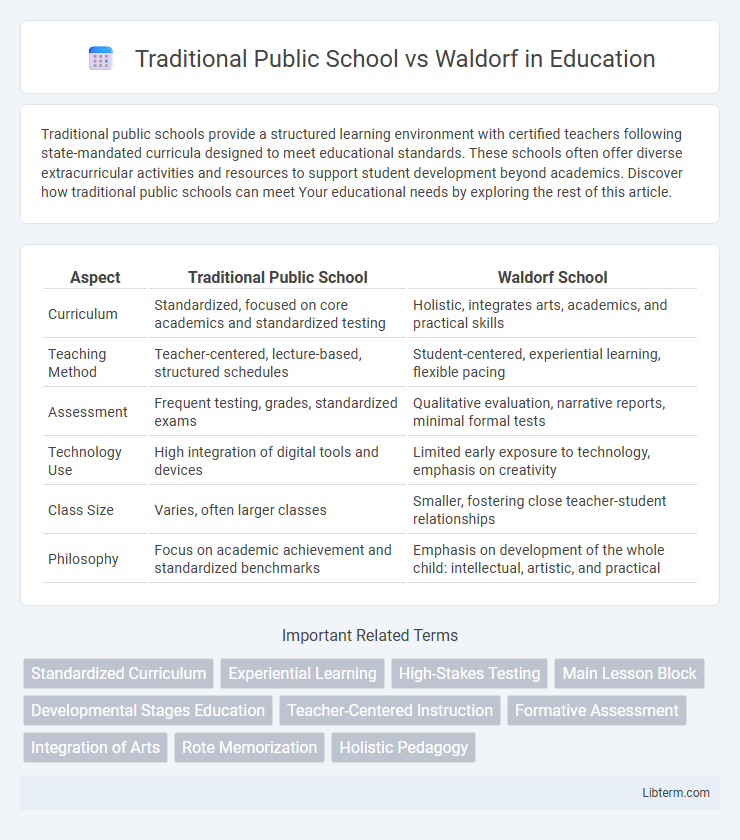Traditional public schools provide a structured learning environment with certified teachers following state-mandated curricula designed to meet educational standards. These schools often offer diverse extracurricular activities and resources to support student development beyond academics. Discover how traditional public schools can meet Your educational needs by exploring the rest of this article.
Table of Comparison
| Aspect | Traditional Public School | Waldorf School |
|---|---|---|
| Curriculum | Standardized, focused on core academics and standardized testing | Holistic, integrates arts, academics, and practical skills |
| Teaching Method | Teacher-centered, lecture-based, structured schedules | Student-centered, experiential learning, flexible pacing |
| Assessment | Frequent testing, grades, standardized exams | Qualitative evaluation, narrative reports, minimal formal tests |
| Technology Use | High integration of digital tools and devices | Limited early exposure to technology, emphasis on creativity |
| Class Size | Varies, often larger classes | Smaller, fostering close teacher-student relationships |
| Philosophy | Focus on academic achievement and standardized benchmarks | Emphasis on development of the whole child: intellectual, artistic, and practical |
Overview of Traditional Public Schools
Traditional public schools follow a standardized curriculum regulated by state education agencies, emphasizing core subjects such as math, science, language arts, and social studies. These schools prioritize measurable academic achievement, standardized testing, and adherence to state standards, ensuring consistent educational outcomes across diverse student populations. Classrooms typically feature teacher-led instruction, structured schedules, and grade-level assessments to prepare students for college readiness and workforce requirements.
Introduction to Waldorf Education
Waldorf education emphasizes holistic development by integrating artistic, practical, and intellectual activities tailored to each child's developmental stages, contrasting with the standardized curriculum of traditional public schools. Established by Rudolf Steiner in the early 20th century, Waldorf schools prioritize imagination and creativity, fostering critical thinking and emotional growth alongside academic learning. This approach cultivates a deep connection to nature and social responsibility, offering an alternative framework focused on nurturing the whole child.
Curriculum Differences
Traditional public schools follow a standardized curriculum focused on core subjects like math, science, reading, and social studies, aimed at meeting state education standards and preparing students for standardized tests. Waldorf education emphasizes a holistic, arts-integrated curriculum that nurtures creativity, imagination, and social-emotional development through project-based and experiential learning tailored to developmental stages. The Waldorf approach delays formal academic instruction in early years, prioritizing play and artistic activities, whereas traditional schools introduce structured academics from the start.
Teaching Methods Compared
Traditional public schools emphasize standardized curricula and direct instruction, utilizing textbooks and assessments to measure academic progress. Waldorf schools focus on experiential learning, integrating arts, music, and hands-on activities to foster creativity and critical thinking. The Waldorf approach prioritizes holistic development, adapting teaching methods to children's cognitive and emotional stages, contrasting with the structured, test-oriented environment of traditional public education.
Classroom Environment and Structure
Traditional public schools typically feature a structured classroom environment with standardized desks, strict schedules, and teacher-led instruction focused on measurable academic outcomes. Waldorf classrooms emphasize a flexible, home-like atmosphere with natural materials, artistic decorations, and a curriculum integrating creativity, imagination, and experiential learning. This approach fosters individualized pacing and holistic development, contrasting with the uniform, test-driven model of traditional public education.
Assessment and Grading Systems
Traditional public schools employ standardized tests and letter grades to evaluate student performance, emphasizing measurable academic achievement aligned with state curricula. Waldorf schools utilize qualitative assessments, narrative reports, and portfolio reviews to focus on individual student development, creative expression, and holistic learning rather than numerical grades. This approach reflects Waldorf's philosophy of fostering intrinsic motivation and personal growth over competitive comparison.
Role of Technology in Learning
Traditional public schools integrate technology extensively, using digital tools and online resources to enhance standardized curriculum delivery and support data-driven assessments. Waldorf schools limit the use of technology in early education, emphasizing hands-on, experiential learning and creativity to foster critical thinking and social skills. The contrast highlights a divide between tech-centric instruction and technology-minimized, holistic pedagogical approaches.
Socialization and Community Involvement
Traditional public schools emphasize diverse peer interaction and structured group activities that foster teamwork, discipline, and social skills within a larger community setting. Waldorf schools prioritize cooperative learning, creative expression, and community engagement through arts, festivals, and service projects that nurture empathetic relationships and deep social bonds. Both models offer distinct approaches to socialization and community involvement, with public schools promoting broader societal integration and Waldorf schools focusing on holistic, inclusive connections.
Cost and Accessibility
Traditional public schools are funded by local, state, and federal governments, making them tuition-free and widely accessible to families across various socioeconomic backgrounds. Waldorf schools, often privately funded, require tuition fees that can range from $10,000 to $30,000 annually, which may limit accessibility for many families. Geographic availability of Waldorf schools is more limited compared to public schools, often concentrated in urban or suburban areas, affecting ease of enrollment and diversity of student populations.
Outcomes and Long-Term Impact
Traditional public schools emphasize standardized testing and curriculum aligned with state standards, often leading to measurable academic outcomes such as higher scores in core subjects. Waldorf education prioritizes holistic development, creativity, and critical thinking, resulting in strong social skills, emotional intelligence, and lifelong learning habits. Long-term impact studies indicate Waldorf graduates demonstrate greater adaptability and innovation in diverse career fields, while traditional students often excel in standardized assessments and conventional academic paths.
Traditional Public School Infographic

 libterm.com
libterm.com